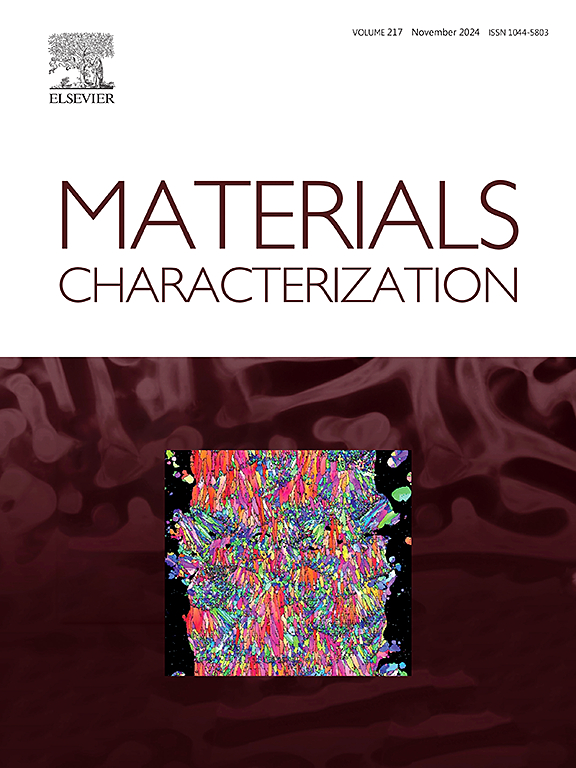等温时效过程中单析出相Al-Cu-Mg合金尺寸演变的预测与定量研究
IF 5.5
2区 材料科学
Q1 MATERIALS SCIENCE, CHARACTERIZATION & TESTING
引用次数: 0
摘要
由于铝合金广泛应用于精密仪器的制造,其尺寸的变化会对最终产品的精度和可靠性产生不利影响。本研究建立了一种预测模型,用于定量估计含单一析出相的Al-Cu-Mg合金在时效过程中的宏观尺寸变化率。通过热力学计算设计了Al-4.33Cu-1.74 Mg wt%的合金成分,发现基体晶格收缩和S相析出是影响尺寸变化率的主要因素。显微组织表征进一步证明了S II相中Mg与Cu的原子比存在偏差,时效24 h后S II相中Mg: Cu的原子比为1.38:1。结合这些发现,将计算得到的S相体积分数与热力学分析得到的晶格常数变化相结合,建立了定量模型。在引入动力学校正因子后,预测的尺寸变化率与实验测量结果非常吻合(例如,在48小时内,- 5.71 × 10−5 vs. - 4.57 × 10−5)。这项工作为准确预测Al-Cu-Mg合金的尺寸稳定性提供了一种全面的方法,为合金设计和精密部件制造提供了有价值的见解。本文章由计算机程序翻译,如有差异,请以英文原文为准。
Prediction and quantitative study on the dimensional evolution of Al-Cu-Mg alloy with single-precipitate phase during isothermal aging
As aluminum alloys are widely employed in the fabrication of precision instruments, their dimensional changes can adversely affect the accuracy and reliability of the final products. In this study, a predictive model was developed to quantitatively estimate the macroscopic dimensional change rate of an Al-Cu-Mg alloy containing a single precipitate phase during the aging process. An alloy composition of Al-4.33Cu-1.74 Mg wt% was designed through thermodynamic calculations, revealing that matrix lattice contraction and S phase precipitation are the dominant contributors to dimensional change rates. Microstructural characterization further demonstrated a deviation in the atomic ratio of Mg to Cu within the S II phase, with a measured Mg: Cu ratio of 1.38:1 in the S II phase after 24 h of aging. Incorporating these findings, a quantitative model was established by combining the calculated volume fraction of the S phase and lattice constant variation obtained from thermodynamic analysis. Upon introducing a kinetic correction factor, the predicted dimensional change rates exhibited excellent agreement with experimental measurements (e.g., −5.71 × 10−5 vs. −4.57 × 10−5 at 48 h). This work offers a comprehensive approach for accurately predicting the dimensional stability of Al-Cu-Mg alloys, providing valuable insights for alloy design and precision component fabrication.
求助全文
通过发布文献求助,成功后即可免费获取论文全文。
去求助
来源期刊

Materials Characterization
工程技术-材料科学:表征与测试
CiteScore
7.60
自引率
8.50%
发文量
746
审稿时长
36 days
期刊介绍:
Materials Characterization features original articles and state-of-the-art reviews on theoretical and practical aspects of the structure and behaviour of materials.
The Journal focuses on all characterization techniques, including all forms of microscopy (light, electron, acoustic, etc.,) and analysis (especially microanalysis and surface analytical techniques). Developments in both this wide range of techniques and their application to the quantification of the microstructure of materials are essential facets of the Journal.
The Journal provides the Materials Scientist/Engineer with up-to-date information on many types of materials with an underlying theme of explaining the behavior of materials using novel approaches. Materials covered by the journal include:
Metals & Alloys
Ceramics
Nanomaterials
Biomedical materials
Optical materials
Composites
Natural Materials.
 求助内容:
求助内容: 应助结果提醒方式:
应助结果提醒方式:


